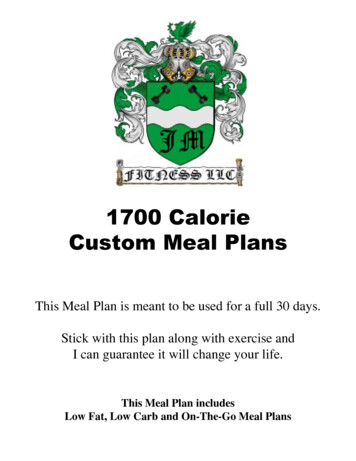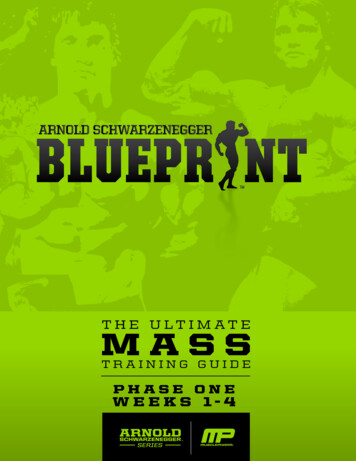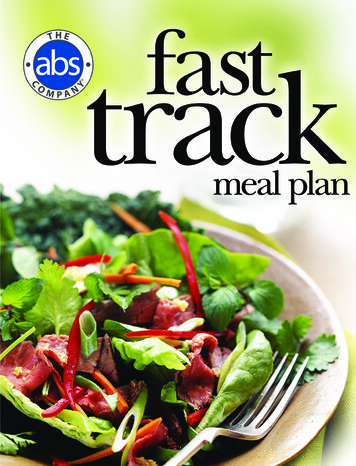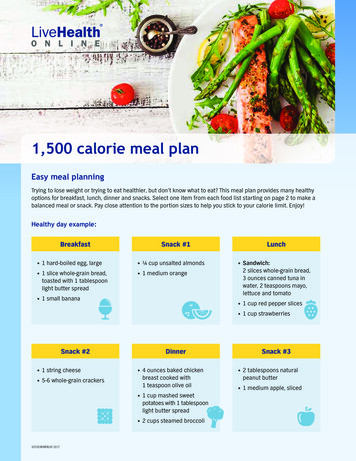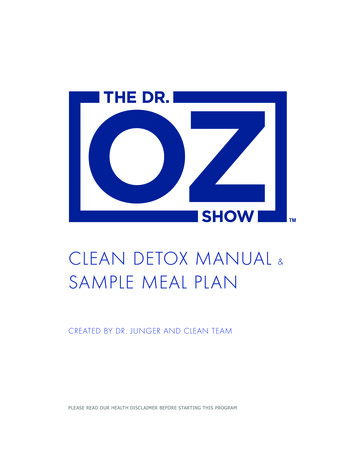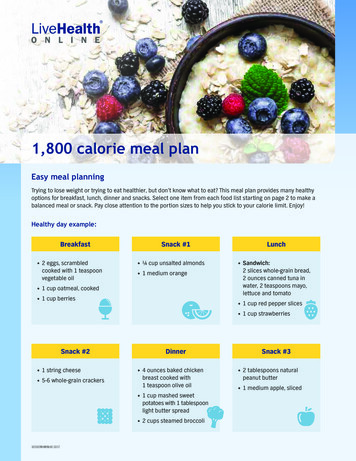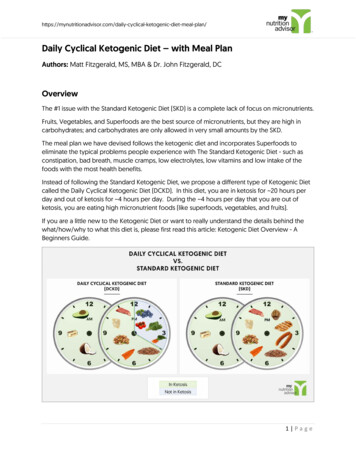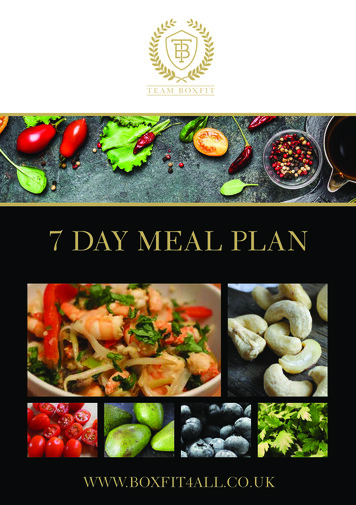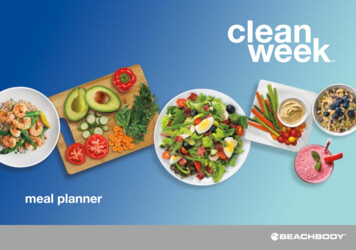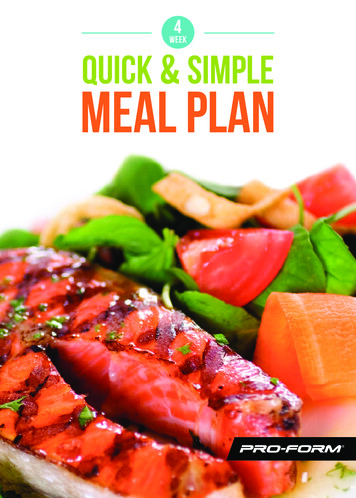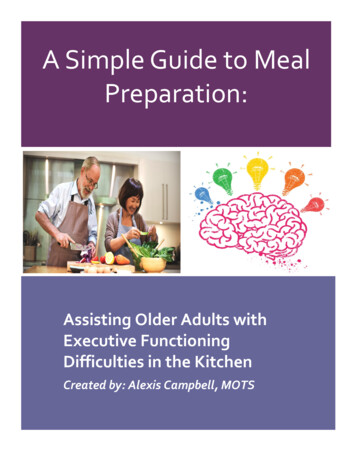
Transcription
A Simple Guide to MealPreparation:Assisting Older Adults withExecutive FunctioningDifficulties in the KitchenCreated by: Alexis Campbell, MOTS
Executive Functioning?Age-related cognitive decline, especially in executivefunctioning (EF) is extremely common among olderadults: it’s important to remember – this is a normalpart of the aging process and you are not alone.What exactly is executive functioning? Higher level cognitive capacities that allow us to engage inself-directed behaviors (Barney & Perkinson, 2016). Common skills related to EF include (Kimbell, A.M., 2012)o Task shifting – can you easily switch between engagingin multiple tasks?o Inhibition of irrelevant information – are you able toignore distractors that are unrelated to the task at hand?o Planning, Initiation & Sequencing of tasks - is itchallenging to complete multi-step activities?o Problem Solvingo Information Processing Speed – does it take longer tounderstand & react to information received?o Attention & Working Memoryo Mental Flexibility – do you find it difficult to switchbetween thinking about or think simultaneously aboutdifferent concepts?
o Time Managemento Emotional Regulation – appropriate use of emotions &managing emotions in stressful situationso Organizational Skills – is it difficult to keep track ofthings?What causes deficits in executive functioning? Changes in the frontal lobe & prefrontal cortex of the braino Loss of neurotransmitterdopamine (DA)o Age-related reductions in whitematter within the brain(Lindenberger et al., 2008)o Reduced volume of prefrontal cortex Changes in our limbic system can also cause EF deficitsrelating to emotional regulation abilities (Lindenberger et al., 2008)What’s the big deal about executive functioning?Executive functioning is a large predictor of functional decline inolder adults. One in four (1:4) older adults will experiencedifficulties in completing activities of daily living (ADLs) as aresult of deficits in EF (Puente et al., 2014). The consequences of thesedeficits often result in a loss of independence & an increased needfor assistance with ADLs. A loss in independence can furthercontribute to associated feelings of decreased self-worth & aperceived lack of competence in participation of dailyoccupations.
Meal PreparationExecutive Functioning & Meal Preparation:Meal prep is a cognitively demanding task that requires severalskills pertaining to EF. So – what areas of meal prep will beaffected by deficits in executive functioning? (listed below are just afew examples) Meal Planning & Time Managemento What materials are needed & how much? How much time will Ineed to complete the task? Assembling Ingredientso Can I locate all identified ingredients needed?(Levine et al., 2000) Misinterpreting instructionso Can I filter out any irrelevant details listed? Do I have tocontinuously check instructions for information? (Levine et al., 2000) Following a sequence of stepso Am I leaving out key steps for preparation? Am I completingsteps in the wrong order? (Levine et al., 2000) Shifting between different taskso i.e., Can I prepare ingredients while maintaining an appropriateworkspace? Can I prepare dry ingredients while cooking on thestove top? Working Memoryo Am I able to remember steps of a task without having to recheck? Do I forget to check on prepared food?
Improving Meal Preparation:Environmental ModificationReducing Clutter & Staying OrganizedClutter within the kitchen and un-organized materials can make for achallenging time when preparing a meal. Clutter and poor organizationalskills can lead to difficult times locating necessary materials & it can alsoserve as a large distractor during task completion. Various tips &techniques can be implemented to help reduce clutter & improveorganization in order to more effectively complete meal preparation.STORAGE BINS & ins-with-handlesstarter-kit/12ld?productId 11010037Place items such as measuring cups,seasonings, Tupperware containers & othersmall materials into these storage bins. Goodfor clearing up counter ips-pop-5piececanisters/d?productId 11010870&q plastic%20containersCan be used to store bulkier foods whosepackaging takes up more space (i.e., pasta,cereal, rice). Also helps to free up space &reduce clutter!
LABELSUse of labels is a simple and effective means for keeping more organized in thekitchen. Creating & attaching labels to frequently used kitchen materials canmake for easier identification as ry-StorageStickers/dp/B01K7Y8OMY/ref sr 1 2?dchild 1&keywords label for containers&qid 1591727713&sr 8-2Sticker labels are cost friendly & easy to create.It might be helpful to place labels on cabinetsand drawers indicating what’s located in eachto make identification easier. You can alsoplace labels on individualized ingredientsmaking them easier to read & identify.Linked below you will find a few different resources that provide other helpful tips forkeeping your kitchen organized & keeping away from clutter during meal ate-a-functionalkitchen/kitchen-organization/ Discusses the creation of cooking zones: prep zone, cook zone, clean-upzone & put away zone Creating a cooking strategy before beginning meal preparation Tips for tidying up your ion-how-to-organize-cabinetskitchen-zones/ Provides very helpful tips regarding cabinet & drawer organization inrelation to the various cooking zones as mentioned above. For example, inthe preparatory zone you would place items such as cutting boards, prepbowls, various utensils, measuring cups, etc.Other tips to consider: Get rid of items you no longer use. Put away dishesimmediately after washing. Use stackable containers to utilize space. Utilizedrawer & cabinet partitions to keep areas more organized.
A Memory Strategy for Meal Prep:Simplified ChecklistCreating a checklist that can be used duringevery meal preparation can help to keep you ontrack & ensure that you aren’t missing anyimportant steps. Instead of just following stepby-step instructions which can often bemisinterpreted a checklist allows you to break down the differentsteps listed and actually learn them in order to prepare a meal moreeffectively.Things to include as part of a checklist include (Levine et al., 2000) What recipe are you preparing? What is the total prep time & cooktime?o This can also help with understanding & practicing time management What ingredients are needed? Am I able to collect all ingredients?o Write down all ingredients that are needed & then go back throughand check-off each ingredient after it has been located. Ask yourself ifyou have everything you need before proceeding. Preparing the ingredientso Are all ingredients combined appropriately? Is everything ready tostart cooking? Following the cooking instructionso Ask yourself if you’ve followed all the steps listed. Did you skip overany steps? Check off the steps one at a time as you go.I’ve inserted the meal preparation checklist that I’ve created at the end of thisdocument for referenceBefore engaging in meal preparation activities, fill out the checklist FIRST with allnecessary information. Keep the checklist on hand throughout the entire task &refer back to list to check off everything that you’ve completed.Other tips: If you have someone else around, have them provide feedback on yourperformance during meal prep. Let them identify things that you might have
struggled with & what you could do to improve. Feedback has been known to bebeneficial in improving learning & performance!Assistive Technologies:There are various assistive technologies available that pertain tocognition & memory that can make meal preparation easier to complete.Listed below are few different devices that might be helpful.Boil t-1-unit/cookingaids-and-appliancesWhen boiling water, place this simple device inthe pan full of water. When it begins to boil thedevice will rattle against the side of the potindicating the water is boiling. This is a simple yeteffective device that can help alert the individualthat it’s time to shift their attention back to the water during meal preparation.Timer on a pe/dp/B000E3FECMWhen preparing a meal, look for indicated cooktime. You can then turn the knob on this timer &set it as a reminder. The device elicits aprolonged loud ring while providing a vibrationthat alerts the individual that the amount of timehas surpassed. This can be beneficial if you findyourself losing track of time while in the kitchen.Additionally, if you find yourself transitioning from task to task you can use thistimer to alert you to shift attention to a different meal preparation task.
Digital Voice n-Operation-ActivationInterview/dp/B081RKZ635?ref s9 apbd otopr hd bw bxFW&pf rd r 9XZHFMYBQZCR4V4WMS6F&pf rd p cf664783-6c46-594c-a456-a017d54083bc&pf rd s merchandised-search10&pf rd t BROWSE&pf rd i 227758If you find yourself frequently having to look backat instructions when cooking, this device might behelpful. You can voice record the cookinginstructions on this device & then replay them backas you move through the meal preparationprocess. Features on this device allow you toreplay recordings at various speeds, rewind, pauseand fast forward.To use: hit the side button to begin the recordingas you read through step-by-step instructions. Hitthe same button again to stop recording. In order to play the recording back youhit the ‘play’ button on the top right of the device. The speed of playback can beadjusted using the double arrows displayed on the right & left. To fast forward orrewind double tap those same arrows.Other Helpful Resource: Cooking ClassesParticipation in a cooking class with other individuals can help improvemeal preparation skills for those with EF deficits as well. How can it help? Education on meal preparation Familiarizing yourself with different kitchen utensils & devices tomake use easier Extra practice with following instructions & task sequencing Allows for feedback on performance and extra guidance Opportunities for social interaction & working with othersClick on links to find local cooking //www.cookingmattersdetroit.org/join-a-class
Who else can help?Cognitive Behavioral Therapists – PsychologistsCBT can assist individuals in understanding thoughts and behaviors &how this plays a role in functioning. Therapists can work onunderstanding current cognitive deficits and introduce effectivestrategies for dealing with these changes. CBT can address things likeemotional regulation, time management & planning strategies – all ofwhich are executive functioning skills. CBT can work with individuals toaddress performance goals; we often see that goals are broken downinto steps & the individual is taught to control their focus & manage theirtime appropriately in order to accomplish a functioning-training/DietitianA dietitian can work with older adults to create simple and modifiedrecipes that are easy to prepare in the kitchen. The dietitian can workdirectly with the older adult to identify any nutritional needs and how toincorporate these into meal preparation tasks without the activitybecoming too overwhelming. Utilizing only a few ingredients fordifferent recipes can limit the task demands for meal preparation,making the task much easier to complete.Primary Care PhysicianAlthough these individuals might not be able to help specifically withmeal preparation, they can be of assistance in addressing executivefunctioning deficits. Physicians can perform assessments to furtherunderstand EF deficits. They can also provide referrals to morespecialized doctors (i.e., psychiatry or neurology) if older adults notice EFdeficits worsening. Additionally, these professionals can prescribe
medications. Some say that stimulant medications can be beneficial foraddressing executive functioning in older adults; it will be important forthe older adult to bring this up to their PCP in order to learn about theeffects of this medication & how they can be of help.Occupational EngagementExecutive functioning can impact participation in various activities ofdaily living. The solutions that have been provided as part of thisresource can help to improve an older adult’s occupational engagement– more specifically pertaining to meal preparation.One area that was addressed as part of my resource is this idea of generaltasks & demands. For example, one of my proposed solutions suggestedthe use of a simplified checklist during meal preparation activities. Achecklist can be used for various tasks carried out as part of a dailyroutine. The checklist can serve as a guide for individuals as theycomplete and further carry out multiple tasks.How might this improve occupational engagement? Utilization of achecklist can help to break down complicated activities into a simplifiedstep-by-step process. Older adults could use this during different selfcare activities (i.e., dressing, brushing teeth, etc.) or even during workrelated activities to complete the task more efficiently & in a stress-freemanner. As a result, we would expect individuals to place higher value onthe activities as they perceive themselves as being able to complete thetask in a simple manner.Other solutions addressed as part of this resource focus more specificallyon the area of domestic life: acquisition of necessities within activity andparticipation. To go even further, these solutions can help improve bothsimple and complex meal preparation. The organization techniques
discussed earlier can help address areas of organization, planning andcooking of meals. The assistive technologies can be helpful for thosewho struggle with attending to multiple tasks at once – which is a hugecomponent of occupational engagement. If an individual is able to carryout daily activities in a less challenging way, it’s likely that we will seeimprovements in overall occupational engagement because these olderadults feel more competent and satisfied with their functional abilities.
ReferencesBarney, K., & Perkinson, M. (Eds.) (2016). Occupational therapy with aging adults: Promotingquality of life through collaborative practice. imbell, A.M. (2012, April 25). Executive functioning across the lifespan: Older adults[PowerPoint slides]. ut4-25-2012.pdfLevine, B., Robertson, I.H., Clare, L., Carter, G., Hong, J., Wilson, B.A., Duncan, J., & Stuss,D.T. (2000). Rehabilitation of executive functioning: An experimental-clinical validationof goal management training. Journal of international neuropsychological society, nload?doi 10.1.1.496.1765&rep rep1&type dfLindenberger, U., Nagel, I.E., Chicherio, C., Li, S.C., Heekeren, H.R., & Backman, L. (2008).Age-related decline in brain resources modulates genetic effects on cognitivefunctioning. Frontiers in neuroscience, 2(2), 234-244. doi: 10.3389/neuro.01.039.2008Puente, A.N., Lindbergh, C.A., & Miller, L.S. (2014). The relationship between cognitivereserve and functional ability is mediated by executive functioning in older adults. Theclinical neuropsychologist, 29(1), 676
Meal Preparation ChecklistWHAT’S THE RECIPE?TIME COMPONENTS:PREP TIME:COOK TIME:*IF INSTRUCTUED PREHEAT OVEN*COOK TIME:COLLECTING THE INGREDIENTS:1.7.2.8.3.9.4.10.5.11.6.12.BEFORE PROCEEDING: Did I identify & collect all ingredients needed? If you forgotan ingredient, make sure to go back now & find it before moving on to the next step.PREPARING THE INGREDIENTS:Write out all measurements / amounts of ingredients needed.You can then proceed with measuring out the amounts &making sure you have everything that you need beforeproceeding.
FOLLOWING STEP-BY-STEP INSTRUCTIONS1.7.2.8.3.9.4.10.5.11.6.12.If you don’t want to write out the instructions for each meal that you prepare, you cansimply print out the recipe that provides instructions for preparation. Create checkboxes next to each step that you can refer back to & check-off as you progress.BEFORE PROCEEDING: Ask yourself, have I followed ALL steps?COOK TIME:SET TIMER FOR COOK TIME.You can set multiple timers on your phone or other appliances to remindyourself to continually check on the food as it cooks.
Can I prepare dry ingredients while cooking on the stove top? Working Memory o Am I able to remember steps of a task without having to re-check? Do I forget to check on prepared food? (Levine et al., 2000) (Levine et al., 2000) (Levine et al., 200

